Solar Dryers For Coffee In Kenya
Solar dryers for coffee in Kenya by Grekkon Limited improve the drying efficiency of harvested coffee cherry. In Kenya, harvested cherry is largely manually open dried which takes 10 – 14 days depending on the location and the prevailing temperatures. Open coffee drying is done on wooden raised table structures with a wire mesh bed laid out where the coffee cherry is spread thinly. The coffee cherry is dried by direct solar radiation and wind movement
Cost of solar dryers for coffee in Kenya
The overall cost of a solar dryer depends on the size. The average price of a large solar dryer for coffee in Kenya is Kes 1,200/M square
Challenges of open coffee drying
- it is labour intensive. This is needed to turn it over every 45 minutes to 1 hour on the bed to ensure eveness of drying, covering it in the evening or on rainy days with a polythene cover to prevent moisture entry. This increases the cost of coffee erries drying
- quality degradation as a result of moisture entry, dirt, elements of nature, and other contaminants
- it requires lots of space because the beds cannot be designed in a storeyed manner
- none uniformity of drying because it is turned over by hand on the raised drying beds

Open drying of coffee cherries in a coffee factory in western Kenya
The key advantage of open sun drying of coffee is that it is cheap, and has zero CO2 emissions
The coffee is dried from 60% to 10% – 11% moisture level. There are six stages in cofee drying
1) Skin drying. Moisture 55-45%.
2) White Stage drying. Moisture 44-33%.
3) Soft Black stage. Moisture 32-22%.
4) Medium Black Stage. Moisture 21-16%
5) Hard Black Stage. Moisture 15-12%
6) Fully dry coffee and conditioning. 11-10%
Coffee drying is a post-harvest handling process where the coffee quality is preserved instead of improving it. Different temperature limits are allowed for different coffee processing methods. Moisture level are checked to prevent moulding on the drying coffee
Solar dryers for coffee in Kenya by Grekkon Limited provide a low cost, efficient, zero CO2 emissions, and a clean way to dry cofee cherry. The use of solar dryers mitigates against the challenges faced under open sun drying.
How does a solar dryer for coffee work?
1. Air in the dryer in contact with the coffee is heated through solar radiation
2. Moisture in the coffee beans rises and is expelled through a ventilation
The temperature in the coffee solar dryer is on or about double that of the ambient temperature
Benefts of a solar dryer for coffee
- the coffee beans are not tuned over manually to achieve eveness of drying. This cuts out the huge labor cost coffee factories incur during coffee drying. Eveness of drying is well achieved as hot air dries every bean uniformly
- there is no external mositure entry especially from rain. This removes any occurence of moulding or mildew
- coffee dries at half the time or less that it would take under direct sun drying. This reduced drying time saves on operational costs
- there are no external contaminants
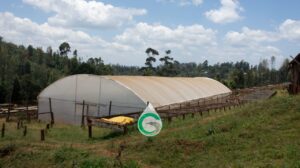
The exterior of a solar dryer built in a coffee factory by Grekkon Limited
- the polythene paper cover used has UV block treatment which preserves the quality of the coffee bean. It also has anti-drip attributes, so that dew does not form on it, then drop on the coffee
- space is eficiently used because the drying racks are stacked up over each other, unlike in open sun drying where each coffee cherry must make contact with the sun’s rays to dry
- in areas where coffee theft in factories is rampant, the solar dryer can be locked to prevent entry. This is not possible under open sun drying
- drying goes on even in hazy, cloudy or rainy conditions. Coffee is thus dried anytime of the year, creating drying efficiencies for the coffee factory
Demerits of a dryer for coffee
- it is expensive to isntall
- the polythene cover has to be changed every 3 -4 years when the UV block treatment has worn off
- it is uncomfortable to work in during the day as the internal temperature is high
- where care is not taken, over-drying of coffee may happen, which reduces its quality and its subsequent market price. A moisturemeter should always be used in the drying process to prevent this
- it requires maintainance, such as replacing the UV block treated polythene sheet every 3 years, when the UV block treatment degrades

A coffee solar dryer working principle
A conventional coffee solar dryer can be enhanced with solar module powered extraction, and exhaust fans, which converts it to a hybrid coffee solar dryer. This will further improve on the drying time as moisture is extracted faster. However, due to the large size of the unit, it is an expensive undertaking. It is largely used in smaller fish, herbs, spices,vegetable and fruit solar dryers
How to install solar dryers for coffee
- create raised tables from timber or galvanised steel not more than 1M in width. The length is as much as can be done. These tables can be storeyed upto 3 levels with vertical gaps of 0.75M – 1M between the levels. The horizontal distance from a table to another is 0.5M
- lay a food grade wire mesh over the tables to hold the coffee. A shade net or insect net can be used. The reason a perforated membrane is laid is to allow for free drying air movement on the beans
- construct the galvanised steel framework over these tables to amaximum mid height of 5M
- lay the greenhouse polythene paper over the steel frame
- place an insect net in the air entry and exit points. An insect net prevents entry of insect pests

A 2 level table bed coffee dryer by Grekkon Limited in Kagumoini area, Nyeri county
Grekkon Limited provides training on proper coffee drying in a solar dryer, and also on the maintainance and managemnt of the solar drying unit after installation to coffee societies in Kenya
(more…)
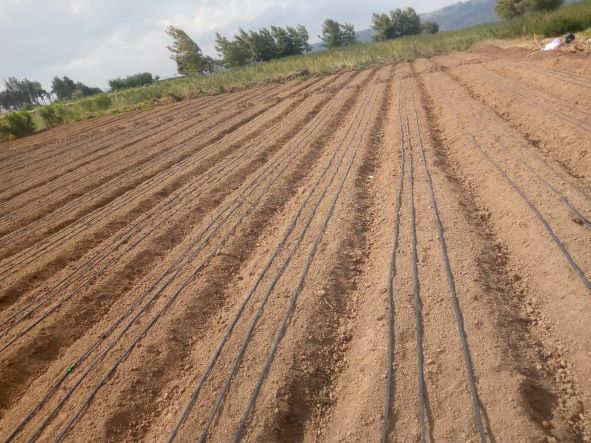
Cost Of Drip Irrigation Per Acre
The cost of drip irrigation per acre in Kenya varies from crop to crop. Grekkon Limited is the top most of all drip irrigation kits suppliers in Kenya. Our drip irrigation system price in Kenya depends on the crop type
For tree crops and hedges, button drippers are installed. In vegetable crops, pre-perforated drip pipes are laid. The emitter spacing on the pre-perforated drip lines is either; 15cm, 20cm, or 30cm. A grower selects according to the vegetable crop type spacing.
We provide our growers a choice of single or double emitter drip irrigation tapes. Double emitter drip lines are helpful in high saline irrigation water locations where salt precipitates form and clog drip emitters. When one emitter is clogged, then the other one continues to irrigate at the same rate. Drip irrigation pipes for sale in Kenya by Grekkon Limited are PVC, and HDPE types
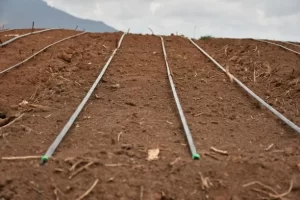
A 3-row drip per bed installation for a vegetable by Grekkon Limited in Ol-Donyo Sabuk area, Machakos county
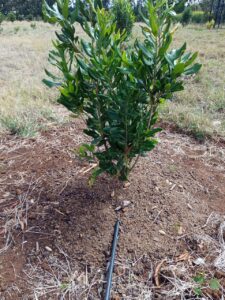
A button dripper irrigation system on macadamia in Item area, Elgeyo Marakwet county by Grekkon Limited
Cost of Drip Irrigation Per Acre
Determining Factors
- Crop type.It determines the crop spacing. Is it a fruit or vegetable garden? Fruit trees and fruit vines or runners such as melons 🍉 take less drip tape per acre. So they have the least cost. Vegetable crops take more drip lines, and are thus more expensive
- Pipe type. It is a PVC or HDPE mainline, and sub-mainline? The former is more expensive to work with
- Water pressure available. The higher the pressure, the less the number of irrigation blocks. Less irrigation blocks per acre means less fittings and accessories, so it’s less expensive. With low pressure, more irrigation blocks are created, at a higher unit cost
I. An Eighth To One Acre Drip Irrigation Kit Prices
| Crop Type | Drip Lines Per Bed | Acreage | Cost in Kes |
| Watermelon | 1 | 1/8 | 15,000 |
| 1/4 | 25,000 | ||
| 1/2 | 45,000 | ||
| 1 | 85,000 | ||
| Tomato, cabbage, chilies, capsicum, green beans, peas | 2 | 1/8 | 25,000 |
| 1/4 | 40,000 | ||
| 1/2 | 75,000 | ||
| 1 | 140,000 | ||
| Onion, garlic, herbs, spices, strawberry | 1/8 | 27,500 | |
| 3 | 1/4 | 45,000 | |
| 1/2 | 85,000 | ||
| 1 | 160,000 |
II. Fruit Tree Button Drip Kit Irrigation Prices
| Crop Type | Acreage | Cost in Kes |
| Tree Tomato/ Pawpaw/ Passion/ Coffee | 1/8 | 15,000 |
| 1/4 | 25,000 | |
| 1/2 | 45,000 | |
| 1 | 85,000 | |
| Avocado | 1/8 | 15,000 |
| 1/4 | 25,000 | |
| 1/2 | 40,000 | |
| 1 | 70,000 |
FAQS
a. How much does it cost to install a drip irrigation system in Kenya?
The tabulated cost of drip irrigation per acre in Kenya includes the cost of installation by our technicians. We conduct our installations in all of east Africa, for every grower. After installation, our agronomy team provides 4 months of free agronomy training for new farmers.
b. How much does drip irrigation cost per hectare?
The cost of drip irrigation per hectare is 2.5 times the cost provided per acre
c. How many drip lines per acre?
This is determined by the crop type. 3,000M for 1 drip row per bed, 6,000M for 2 drip rows per bed, and 8,000M for 3 drip rows per bed
4. What is the maximum length of a drip irrigation line?
Your 16mm drip irrigation line will run for 25 to 27M under gravity flow, where the head is below 10M. From 10M head, this will go up to 50M
5. How far apart are drip irrigation holes?
Our emitter spacing is; 15cm, 20cm, and 30cm
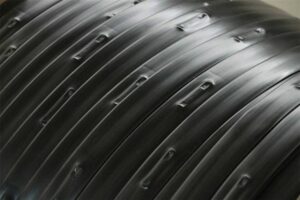
15cm drip emitter spacing on a 1,00M single emitter drip roll
6. How do I calculate drip irrigation?
- Determine the emitter spacing, for example 15cm
- Divide the drip length by this spacing to determine the number of emitters per roll. In our case, 1,000M divided by 0.15M= 6,667 emitters
- Multiply the emitters by the number of rolls per acre, for example 6 rolls, so 40,000 emitters per acre
- Multiply the emitter flow rate by the total number of emitters to get the amount of water discharged per hour. For example 1.5 litres per hour x 40,000= 60,000 litres per hour
7. Which pipe is best for drip irrigation?
HDPE pipes are the best as main and sub main lines because they have UV treatment. This means that they will be used either as surface or sub-surface pipes
8. Can you run a drip line uphill?
Yes. But the head of the flow must be higher than the vertical height of the slope
9. What pipe size should I use for drip irrigation?
The size of the main or sub main pipe installed is determined by the area under irrigation. The larger it is, the larger the pipes used
10. How do I know how long to run drip irrigation?
This is determined by the existing level of soil moisture. Run it for 20 minutes to 1 hour according to the amount of water needed
11. How do I increase the pressure in my drip irrigation system?
They are several ways to raise the irrigation water pressure in your drip irrigation system
i. Divide the farm into blocks, each of which is irrigated separately. This way, irrigation water is channeled to particular block under high pressure
ii. If it is by gravity flow, then by raising the storage elevation. This will work where raised water tanks are the source of irrigation water
iii. By introducing an external source of pressure, such a s water pump to boost the flow of irrigation water in the system
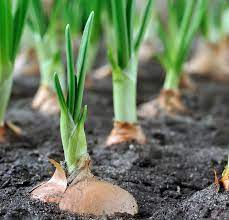
Onion Farming In Kenya
Grekkon Limited supports onion farming in Kenya through provision of onion irrigation systems that make farmers optimise maximum yields, and income. These irrigations systems are distinct for the 2 main stages of onion; seedling and after transplanting. We provide 3 irrigation systems options for onion production. They are;
1. Sprinkler irrigation systems
- small plastic impact sprinklers for small acreage. They range from 1/2″ to 1″
- large metallic rain gun sprinklers for large acreage. They range from 1″ to 2.5″
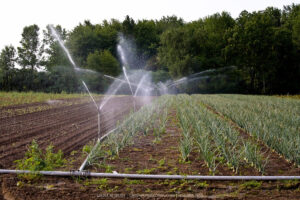
Sprinklers in an onion farm
2. Rain hose kit
This is a pre-perforated 100M long HDPE pipe that is laid on the ground to irrigate vertically and horizontally. Our diameter sizes are; 1″, 1-1/4″ and 1-1/2″
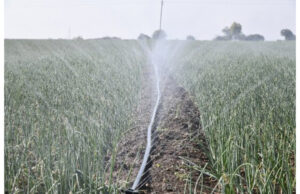
Rain hose irrigation on onion
Both the sprinkler and rain hose irrigation systems share these common characteristics
i. They consume large amounts of water
ii. They are easy to install and operate
iii. Both require high pressure for optimum water flow
iv. Both work well in onion nurseries
v. They water everywhere in the farm, so weeding costs are high
vi. They are inexpensive to install
vii. Material and installation cost per acre is Kes 65,000
3. Drip irrigation
We provide 16mm diameter drip lines with double emitter spacing of 15cm, and a flow rate of between 1.5L per hour for onion farming in Kenya. There is a choice of 0.3mm, and 0.4mm wall thickness. All are treated to last for 4 -6 years in the farm
- drip irrigation has the least water consumption
- works under low gravity pressure
- it delivers the crop directly to the crop, so very low weeding cost
- it is expensive to procure and install
Onion drip kit prices
| Acreage | Cost In Kes |
| Kitchen garden | 20,000 |
| 0.125 | 27,500 |
| 0.25 | 45,000 |
| 0.50 | 85,000 |
| 0.75 | 130,000 |
| 1 | 165,000 |
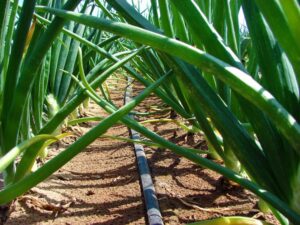
Onion production under drip irrigation
Onion Farming In Kenya
Summary
We provide 4 months of free agronomy support to new onion farmers in Kenya. This is after installation of an irrigation system from us. A detailed onion production manual is provided to the grower showing;
- soil management
- seed selection
- a nutrition program
- chemical spray program
- pest and disease management
Pixie Orange Farming And Irrigation
Pixie orange farming and irrigation in Kenya is a high investment, high returns farming venture. Pixies originate from California, USA where they were developed as a cross between oranges and tangerines. They are yellow-orange in colour, sweet and seedless fruits rich in vitamin C. They boost the immune system and increase collagen production which is great for the skin. In this piece, we answer commonly asked questions on pixie orange farming and irrigation by growers in Africa
1.How do you grow pixie oranges in Kenya?
They grow in most soils, but the best are deep (at least 18 inches or 42 cm deep) fertile sandy loams with a pH range of 6.5 – 7.3
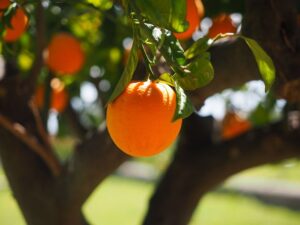
Ripe pixie oranges on a tree
2. How do you plant pixie oranges?
The dimensions of the planting holes are 2ft x 2ft x 2ft. This allows for water conservation and deep root penetration as the tree grows. mix the top soil thoroughly with well decomposed manure especially in weak soils
3. What is the spacing for pixies?
Row to row 5M, plant to plant 4M to give an average population of 200 plants per acre. A mature full-sized tree tree is 6M – 9M tall, and equally wide with an extensive root system
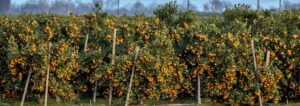
A mature well spaced pixie orange crop
4. How long do pixie oranges take to grow out?
Pixie oranges take 2 years to their first fruiting season, but full maturity is between 3 -5 years
4. How many oranges will one tree produce?
The first fruits (30 – 50 fruits) come in the second year, then 250 -300 in the third to fifth years. By the eighth year, the tree bears 500 -600 fruits annually. To produce this commercial quantity all year round, irrigation must be undertaken
5. How many pixie orange trees per acre?
200 trees on average
How To Irrigate Pixie Oranges In Kenya
Pixie oranges require a high amount of water to grow because they are ever green. Under rain fed production, it will be at least 1,000mm of rain annually. However, to produce commercially, irrigation will be done to supplement rain. A tree will have 20 litres at planting, and thereafter, ensure that the soil is consistently moist, but not soggy. The root system must not be allowed to dry out, and neither should there be standing water. Irrigation is at the root zone, away from the trunk
Pixie Orange Farming And Irrigation
Methods
I. Sprinkler Irrigation
Micro sprinklers at the base of the plant are the most efficient or all overhead irrigation methods. Micro sprinklers are low-pressure, low to medium volume irrigation equipment that deliver water directly to the crop root zone. They provide full scale surface irrigation, and localised watering of trees
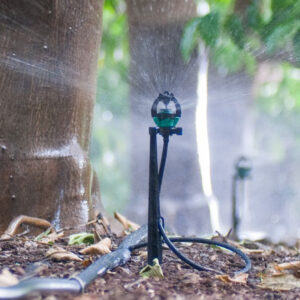
Micro sprinklers installed by Grekkon Limited in an orchard
II. Button drippers
This is the most water conserving and efficient irrigation system. The water loss to evaporation is less than that of micro-sprinklers, and it requires lower pressure to operate

A button drippers system installed by Grekkon Limited at work in a newly established fruit farm
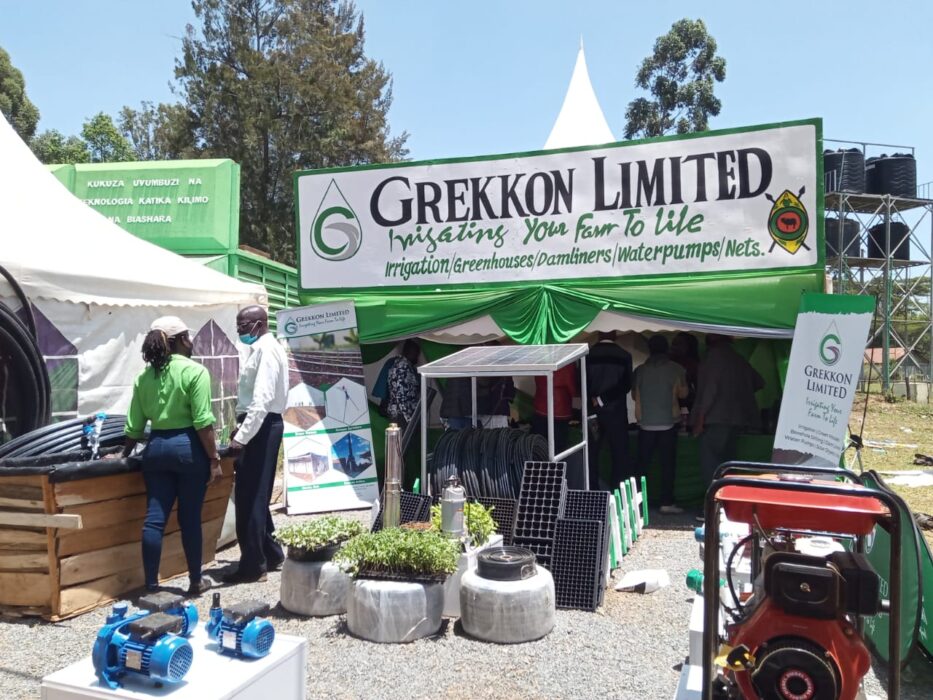
Irrigation Company In Eldoret
The story of an irrigation company in Eldoret begins five years ago. In 2017, two Kenyan agri-prenuers came together to establish an irrigation systems firm to serve small to medium scale commercial farmers in Kenya. This was by providing tailored professional irrigation systems set up solutions that were within these farmers’ budgets. At the same time, improving the clients’ overall yield, and income from farming. The motivation to focus on this niche was because of the presence of large international irrigation service providers. Their clientele were the large ornamental, cereal and vegetable growers. Smaller growers had to fend for themselves because they were never a priority for these large corporates.
The other objective was to do further by offering expert irrigation, greenhouse, water pumps, and dam lining expertise. This is to small scale to medium scale commercial farmers, who had no professional entity to consult for such. It was through physical site visits to carry out assessments, provide advice, and carry out irrigation project reviews afterwards. And so, Grekkon Limited – Irrigation Hub was born.
The headquarters are Nairobi, Kenya’s capital. In April 2018, Grekkon Limited opened Eldoret irrigation hub along Kapsabet road in Kaburwa area within Eldoret municipality.
In mid-2021, the company opened a sub-branch in Eldoret town central business district. This is to serve farmers picking none bulky items such as irrigation fittings and accessories. The new sub-branch is located in Sugarland plaza, along Oloo street.
The irrigation company in Eldoret serves growers in; Nandi, Usain-Gishu, Bungoma, Trans-Nzoia, West Pokot, Turkana, Elgeyo Marakwet, and Baringo counties. These counties have varying climatic conditions and weather patterns. Those in the south are green with predictable rain patterns, hose in the north are arid and semi-arid locations.
Innovation
Grekkon Limited is the first irrigation systems company in eastern Africa to introduce the rain hose irrigation system. This new product solved many irrigation challenges for commercial vegetable and corn farmers. The company is the market leader in research and commercialization of natural solar dryers. Each unit designed to meet the product or market drying requirements. Today, Grekkon Limited is the largest supplier of natural solar dryers in western Kenya, and the north rift regions.
Team
Grekkon Limited’s resounding success is largely due to its team of field professionals in Nyahururu. They provide engineering, commercial, and technical services. In a first in the market, the company organizes ‘training days’ in various regions of the counties. Here, where growers come to learn of new and existing technologies. This knowledge sharing module has proved effective in addressing basic irrigation challenges that farmers go through. It has created trust in the company’s expertise.
Irrigation Company In Eldoret
The Future
There is a growing number of medium scale farmers living in the cities, but farming in the upcountry. The need to create a web-based irrigation monitoring system is more pronounced than ever. Grekkon Limited’s IT team is developing a gadget responsive tool. It will enable farmers to irrigate and fertilise (through fertigation) their farms remotely. It also woks s a moisture monitoring tool to alert growers when crop moisture levels fall below normal levels.
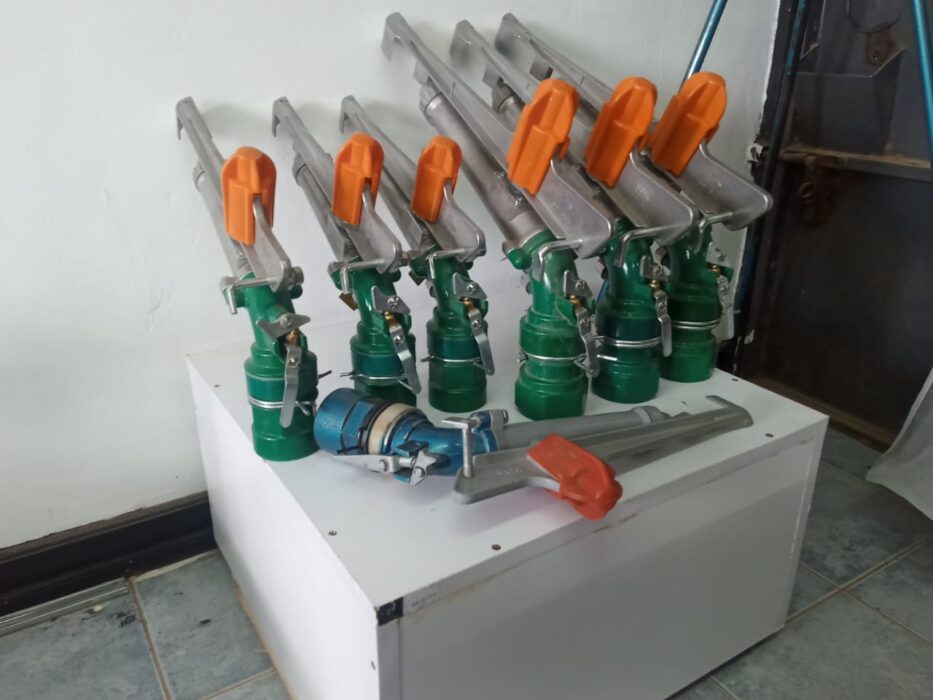
Irrigation Company In Meru
The premier irrigation company in Meru started long before it set up shop in the region. In 2017, two Kenyan agri-prenuers came together to establish an irrigation systems firm to serve small to medium scale commercial farmers in Kenya. This was by providing tailored professional irrigation systems set up solutions that were within these farmers’ budgets. At the same time, improving the clients’ overall yield, and income from farming. The motivation to focus on this niche was because of the presence of large international irrigation service providers. Their clientele were the large ornamental, cereal and vegetable growers. Smaller growers had to fend for themselves because they were never a priority for these large corporates.
The other objective was to do further by offering expert irrigation, greenhouse, water pumps, and dam lining expertise to these small scale to medium scale commercial farmers, who had no professional entity to consult for such. This was through physical site visits to carry out assessments, provide advice, and carry out irrigation project reviews afterwards. And so, Grekkon Limited – Irrigation Hub was born
It was headquartered in Nairobi, Kenya’s capital, and in February 2021, Grekkon Limited opened Meru irrigation hub in Riverbank area of Meru town.
The irrigation company in Meru serves farmers in; Embu, Tharaka Nithi, Meru, Laikipia, Isiolo, and Marsabit counties.
Innovation
Grekkon Limited is the first irrigation systems company in eastern Africa to introduce the rain hose irrigation system. This new product solved many irrigation challenges for commercial vegetable and corn farmers. The company is the market leader in research and commercialization of natural solar dryers. Each unit designed to meet the product or market drying requirements. Today, Grekkon Limited is the largest supplier of natural solar dryers in Isiolo, Embu, Laikipia, Marsabit, Meru, and Tharaka- Nithi regions.
Team
Grekkon Limited’s resounding success is largely due to its team of field professionals in Nyahururu. They provide engineering, commercial, and technical services. In a first in the market, the company organizes ‘training days’ in various regions of the counties. Here, where growers come to learn of new and existing technologies. This knowledge sharing module has proved effective in addressing basic irrigation challenges that farmers go through. It has created trust in the company’s expertise.
Irrigation Company In Meru
The Future
There is a growing number of medium scale farmers living in the cities, but farming in the upcountry. The need to create a web-based irrigation monitoring system is more pronounced than ever. Grekkon Limited’s IT team is developing a gadget responsive tool. It will enable farmers to irrigate and fertilise (through fertigation) their farms remotely. It also woks s a moisture monitoring tool to alert growers when crop moisture levels fall below normal levels.
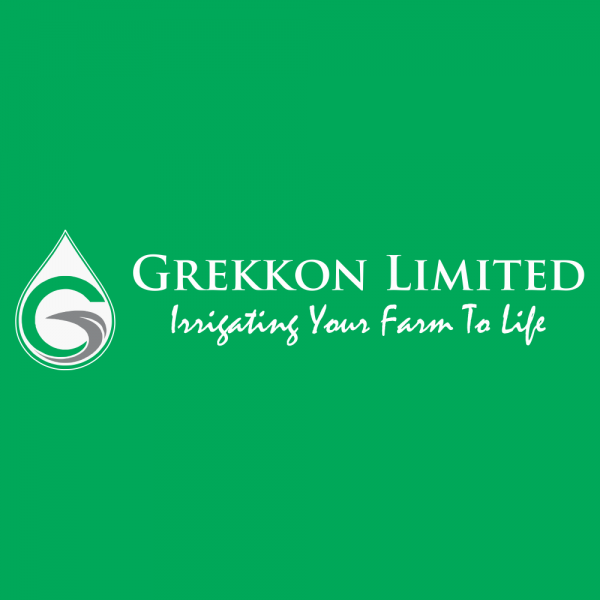
Irrigation company in Kisumu
Before Grekkon Limited started opened an office as an irrigation company in Kisumu, it was already selling in that market. In 2017, two Kenyan agri-prenuers came together to establish an irrigation systems firm to serve small to medium scale commercial farmers in Kenya. This was by providing tailored professional irrigation systems set up solutions that were within these farmers’ budgets. At the same time, improving the clients’ overall yield, and income from farming. The motivation to focus on this niche was because of the presence of large international irrigation service providers. Their clientele were the large ornamental, cereal and vegetable growers. Smaller growers had to fend for themselves because they were never a priority for these large corporates.
The other objective was to do further by offering expert irrigation, greenhouse, water pumps, and dam lining expertise to these small scale to medium scale commercial farmers, who had no professional entity to consult for such. This was through physical site visits to carry out assessments, provide advice, and carry out irrigation project reviews afterwards. And so, Grekkon Limited – Irrigation Hub was born.
It was headquartered in Nairobi, Kenya’s capital, and in February 2021, Grekkon Limited opened Kisumu irrigation hub along Kakamega in Kondele area of Kisumu city.
The irrigation company in Kisumu serves farmers in; Migori, Kisii, Nyamira, Homa-bay, Kericho, Kisumu, Siaya, Kakamega, Busia.
Innovation
Grekkon Limited is the first irrigation systems company in eastern Africa to introduce the rain hose irrigation system. This new product solved many irrigation challenges for commercial vegetable and corn farmers. The company is the market leader in research and commercialization of natural solar dryers. Each unit designed to meet the product or market drying requirements. Today, Grekkon Limited is the largest supplier of natural solar dryers in Nyanza region, and western Kenya.
Team
Grekkon Limited’s resounding success is largely due to its team of field professionals in Nyahururu. They provide engineering, commercial, and technical services. In a first in the market, the company organizes ‘training days’ in various regions of the counties. Here, where growers come to learn of new and existing technologies. This knowledge sharing module has proved effective in addressing basic irrigation challenges that farmers go through. It has created trust in the company’s expertise.
Irrigation Company In Kisumu
The Future
There is a growing number of medium scale farmers living in the cities, but farming in the upcountry. The need to create a web-based irrigation monitoring system is more pronounced than ever. Grekkon Limited’s IT team is developing a gadget responsive tool. It will enable farmers to irrigate and fertilise (through fertigation) their farms remotely. It also woks s a moisture monitoring tool to alert growers when crop moisture levels fall below normal levels.
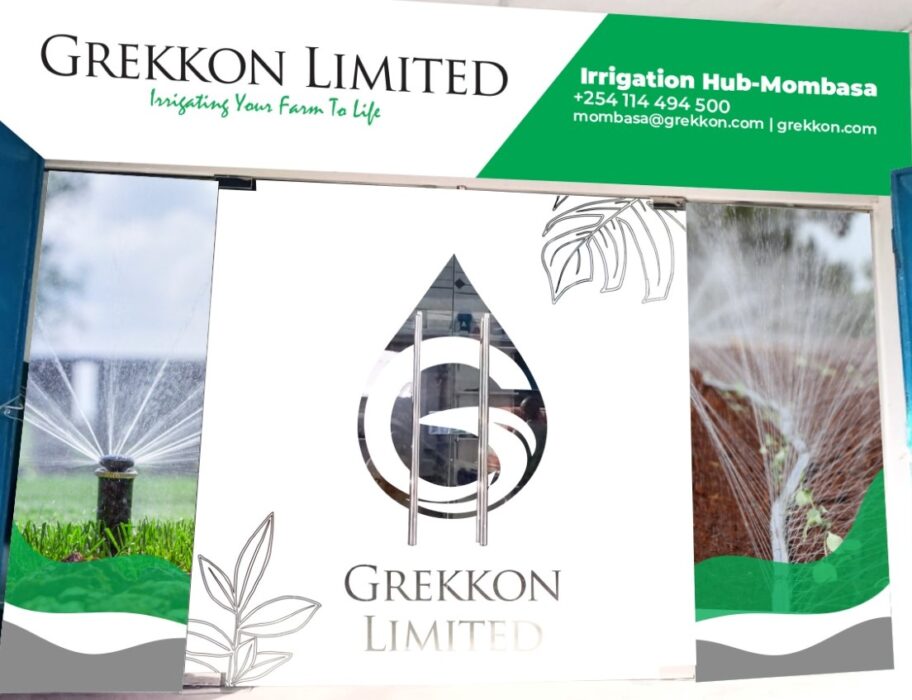
Irrigation Company in Mombasa
In commemoration of our 5 years of serving farmers, Grekkon Limited has a new irrigation company in Mombasa. Grekkon Limited – Irrigation Hub, Mombasa opened it’s doors on the 7th of February 2022. This is 5 years after the first office started operations from Nairobi. Grekkon Limited – Irrigation Hub, Mombasa is located along Jomo Kenyatta Avenue, opposite the Mombasa Pentecostal Church.
Irrigation Company in Mombasa
Products
Irrigation systems
1.1. Drip irrigation
- double emitter pre-perforated drip tapes for vegetables
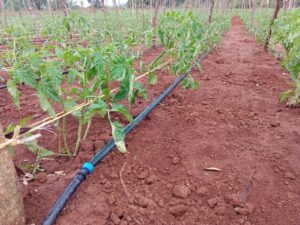
tomato drip irrigation
- button drip irrigation systems for orchards, and forestry
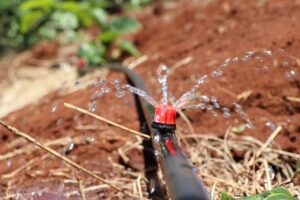
button drip system on avocado
1.2. Sprinkler systems
- rain gun sprinklers to irrigate large diameters
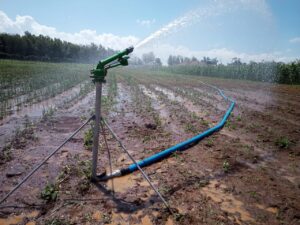
flange type rain gun sprinkler
- impact sprinklers for small to medium scale farms
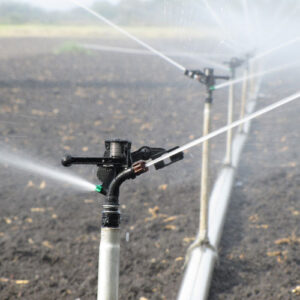
plastic impact sprinklers
- pop up sprinklers for lwans
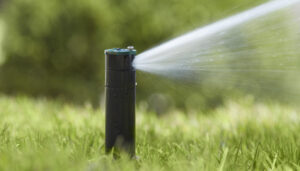
lawn pop up sprinkler
- butterfly sprinklers for small gardens and lawns
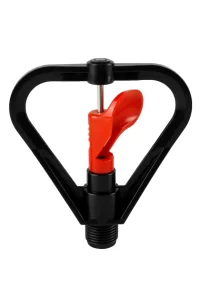
butterfly sprinkler
- meganet sprinklers
- micro sprinklers for lawns and orchards
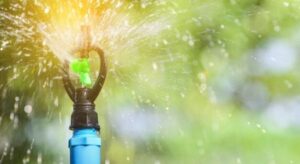
micro sprinkler
1.3. Rain hose kits. These are pre-perforated pipes through nano technology that provide overhead irrigation
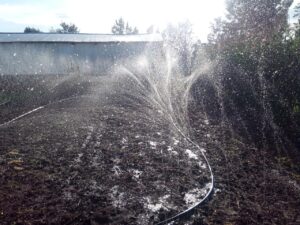
rain hose irrigation system
Every irrigation system comprises of a main line and/or a sub main line. These pipes are either high density polyethylene pipes (HDPE), polyvinyl chloride pipes (PVC), or PVC delivery pipes. Every pipe type has it’s own fittings
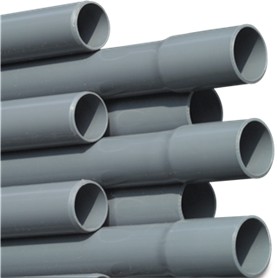
PVC Pipes by Grekkon Limited

16mm HDPE pipes
2. Dam liners
These are UV treated HDPE geomembranes as;
- 0.5mm. for fine textured surfaces
- 0.75mm. for surfaces with murram
- 1mm. for rocky/ stony surfaces

a dam liner on a reservoir
3. Greenhouses
They are categorised by shape, and/or by main frame material
3.1. By shape. They are either tunnel type which are constructed in highland or cool locations. Or vented type done in warm or mid-low altitude areas
3.2. By structural material. They are either steel or wooden. All wooden greenhouse are ‘vented types’
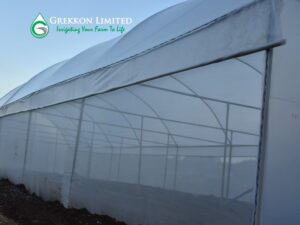
a steel frame, tunnel type greenhouse
4. Solar dryers
These are crop drying units made from galvanised steel with a UV treated polythene paper cover.
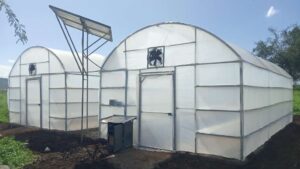
solar dryers in Taveta by Grekkon Limited
5. Water pumps
5.1. Solar water pumps for shallow and deep wells
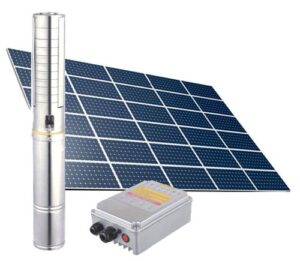
solar water pumps
5.2. Electric surface and submersible pumps
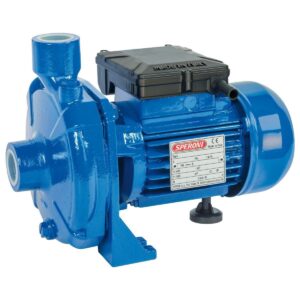
electric surface water pump
5.3. Diesel generator water pumps
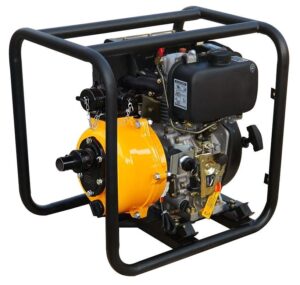
diesel water pump
5.4. Petrol generator pumps
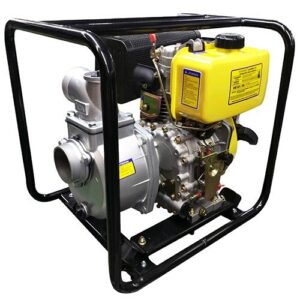
6. Agriculture nets
6.1. Shade nets. They shade the crop from excess sunlight. They are supplied as; 30%, 55%, 75%, and 90% shade
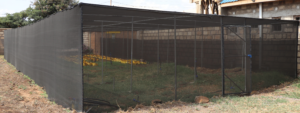
a shade net structure
6.2. Insect nets. They protect the crop from insects. They are supplied as light or heavy gauge
6.3. Bird nets. They protect the crop from bird pests
7. Planting trays and coco peat
Planting trays as; 28, 50,66, 128, 200, and 288 cells for all crops. These come with coco peat planting media
Irrigation company in Mombasa
Service
We provide tailored agronomy support service to all our farmers in east Africa. A detailed crop production hand book detailing all key aspects of crop production is given in every project
